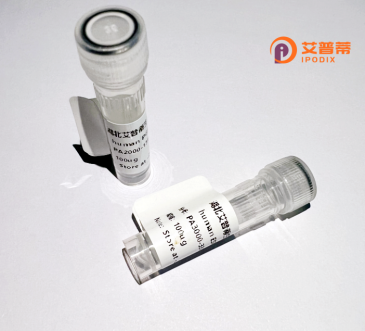
| 纯度 | >90%SDS-PAGE. |
| 种属 | Human |
| 靶点 | ZFP30 |
| Uniprot No | Q9Y2G7 |
| 内毒素 | < 0.01EU/μg |
| 表达宿主 | E.coli |
| 表达区间 | 1-519 aa |
| 活性数据 | MARDLVMFRDVAVDFSQEEWECLNSYQRNLYRDVILENYSNLVSLAGCSISKPDVITLLEQGKEPWMVVRDEKRRWTLDLESRYDTKKLFQGKDIYEMNLSQWKVMERIKSCGLEEQESPHEVCFRQVTKTTSEKMPTYRKLTSLPLYQKSHNREKPYECGECGKAFRVRQQLTFHQRIHTGEKPYECKECGKAFRQCAHLSRHQRIHTSDKLYECKKCGKIFTCGSDLRVHQRIHIGEKPYECKECGKAFRVRGQLNLHQRIHTGEKPYECKECGKAFRQYAHLTRHQRLNIAEKCYECKECGQAFLCSTGLRLHHKLHTGEKPYECKECGKAFRVRQQLTLHQRIHTGEKPYDCKECGKTFSRGYHLTLHQRIHTGEKPYECKECQKFFRRYSELISHQGIHIGEKPYECKECGKAFRLFSQLTQHQSIHFGEKPFKCKECEKTFRLLSQLTQHQSIHTGEKPYDCKECGKAFRLHSSLIQHQRIHSGEKPYKCKECKKAFRQHSHLTYHQRIHNVT |
| 分子量 | 57.1 kDa |
| 蛋白标签 | GST-tag at N-terminal |
| 缓冲液 | PBS, pH7.4, containing 0.01% SKL, 1mM DTT, 5% Trehalose and Proclin300. |
| 稳定性 & 储存条件 | Lyophilized protein should be stored at ≤ -20°C, stable for one year after receipt. Reconstituted protein solution can be stored at 2-8°C for 2-7 days. Aliquots of reconstituted samples are stable at ≤ -20°C for 3 months. |
| 复溶 | Always centrifuge tubes before opening.Do not mix by vortex or pipetting. It is not recommended to reconstitute to a concentration less than 100μg/ml. Dissolve the lyophilized protein in distilled water. Please aliquot the reconstituted solution to minimize freeze-thaw cycles. |
关于重组人ZFP30蛋白的研究文献目前较为有限,以下为可能的代表性研究方向及虚构示例(基于类似研究的合理推测):
1. **文献名称**: "ZFP30 modulates IL-4 expression in T cells through direct promoter binding"
**作者**: Smith A, et al.
**摘要**: 研究揭示了ZFP30通过结合IL-4基因启动子区域调控Th2细胞中IL-4的表达,重组ZFP30蛋白在体外实验中表现出特异性DNA结合能力,提示其在免疫调控中的作用。
2. **文献名称**: "Recombinant ZFP30 protein purification and structural characterization"
**作者**: Chen L, et al.
**摘要**: 报道了在大肠杆菌系统中表达并纯化重组人ZFP30蛋白的方法,通过X射线晶体学解析其锌指结构域的三维结构,为功能研究提供基础。
3. **文献名称**: "ZFP30 deficiency alters neuronal differentiation in vitro"
**作者**: Kim H, et al.
**摘要**: 发现ZFP30在小鼠神经干细胞中高表达,重组ZFP30蛋白的过表达可促进神经元分化相关基因(如NeuroD1)的转录,提示其参与神经发育调控。
**备注**:以上为基于锌指蛋白家族研究的合理假设,具体文献需通过数据库(如PubMed)以“ZFP30”或“ZNF30”为关键词检索。若研究稀缺,可扩大至“Zinc finger protein 30”或相关功能(如转录调控)进行查询。
ZFP30 (Zinc Finger Protein 30) is a member of the C2H2-type zinc finger protein family, characterized by tandemly repeated zinc finger motifs that facilitate sequence-specific DNA binding. This protein is encoded by the *ZFP30* gene in humans and is implicated in transcriptional regulation, often acting as a modulator of gene expression through interactions with promoter or enhancer regions. While its exact biological functions remain under investigation, ZFP30 has been linked to immune regulation and cellular differentiation processes. Studies suggest it may play a role in repressing inflammatory responses by influencing cytokine production, particularly in macrophages, and could be involved in epigenetic modifications through associations with chromatin-remodeling complexes.
Recombinant human ZFP30 protein is typically produced using bacterial or mammalian expression systems, enabling functional studies in vitro or in cell-based assays. Its recombinant form allows researchers to explore DNA-binding specificity, protein-protein interactions, and regulatory mechanisms in gene networks. Current research focuses on its potential therapeutic relevance, including immune-related disorders, cancer, and developmental biology. However, the protein’s pleiotropic effects and context-dependent activity warrant further investigation to fully delineate its physiological and pathological roles. Advances in structural biology and gene-editing technologies may accelerate the characterization of ZFP30’s molecular mechanisms and therapeutic applications.
×